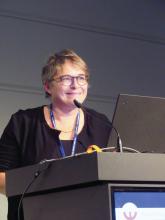BERLIN – Researchers are honing in on several sets of genes that, when altered by as-yet-unknown factors, may signal conversion to full-blown psychosis in people at ultrahigh risk for the disorder.
If confirmed, these candidate markers might have potential as blood-based biomarkers to predict conversion risk and assist in clinical staging, Marie-Odile Krebs, MD, PhD, said at the meeting of the World Psychiatric Association.
The genes modulate three biologic pathways that also have been implicated in schizophrenia: glutathione metabolism, axonal targeting, and inflammation, said Dr. Krebs of Saint-Anne Hospital, Paris. “Knowing this may even help us to target some drugs that work in those pathways,” she said.
Among ultrahigh-risk patients, the conversion rate to full-blown psychosis can be as high as 30%-40% in the 2-3 years after the prepsychotic phase manifests. “However, we do see huge variability within these subjects,” Dr. Krebs said, making it very tough to predict any individual risk of conversion or later progression. “We need biomarkers for better prediction, better staging and differential diagnosis, and a better understanding of the biological processes underlying the onset of psychosis.”Several blood-based analyte screens have been investigated with mixed results, Dr. Krebs noted.
In 2015, researchers at the University of North Carolina at Chapel Hill, and Harvard Medical School, Boston, created a 15-analyte plasma panel that performed well in the North American Prodrome Longitudinal Study (NAPL-S) cohort. The project is a multisite endeavor that aims to better understand predictors and mechanisms for the development of psychosis. The panel separated 35 unaffected controls from 32 with high-risk symptoms who converted to psychosis and from 40 who did not, with an area under the curve (AUC) of 0.91 (Schizophr Bull. 2015 Mar;41[2]:419-28).
Selected from an initial group of 185 analytes, the candidate markers were inflammatory cytokines, proteins modulating blood-brain barrier inflammation, and hormones related to the hypothalamic-pituitary axes. Several also were involved in reacting to oxidative stress.
Earlier this year, members of that same group identified a set of nine microRNAs related to cortical thinning in patients who converted to psychosis. These microRNAs also have been implicated in brain development, synaptic plasticity, immune function, and schizophrenia (Neuropsychopharmacology. 2017 Feb 10. doi: 10.1038/npp.2017.34).
Although these studies are helpful signposts, Dr. Krebs said they do not reflect the dynamic interaction of disease risk, which includes not only the intrinsic factors of genetics, enzymes, and proteins, but the extrinsic risks imposed by other factors: stress, trauma, cannabis use, and other completely individual experiences. “This is a dynamic process, and we need a dynamic assessment,” she said.
To that end, Dr. Krebs and her colleagues decided to look at methylomic changes in a small group of 39 patients at ultrahigh risk for psychosis conversion. All of these patients (mean age, 22 years) were seen at Saint-Anne Hospital from 2009 to 2013. Using whole blood, Dr. Krebs performed a genomewide DNA methylation study to determine what genes – if any – were differently methylated between the converters and nonconverters. The mean follow-up was 1 year (Mol Psychiatry. 2017 Apr;22[4]:512-8).
Although no significant difference was found in global methylation associated with conversion, Dr. Krebs did find longitudinal changes associated with conversion in three regions.
A cluster of five genes in the glutathione S-transferase family was differently methylated between the converters and nonconverters. Two were related to the GSTM5 promoter gene, which encodes for cytosolic and membrane-bound glutathione S-transferase – an important antioxidant enzyme, the downregulation of which has been implicated in schizophrenia. These two regions appeared to be stable over time, suggesting that methylation occurred before conversion, Dr. Krebs said.
Oxidative stress has been implicated in schizophrenia, and GSTM5 is expressed in the brain, Dr. Krebs noted. Some researchers suggest the gene is involved in dopamine metabolism. It’s also underexpressed in the prefrontal cortex of schizophrenia patients.
Three other regions in the GST family changed with conversion: two on the glutathione S-transferase theta 1 gene and one on the glutathione S-transferase P gene. Since all of these have to do with production of the innate antioxidant glutathione, “these findings suggest a potential use for antioxidant drugs,” Dr. Krebs said.
She found two other differently methylated regions as well.
One was a cluster of eight genes that are all involved in axon guidance – the process by which axons branch out to their correct targets. The second cluster comprised seven genes, all of which are involved in regulating interleukin-17 signaling. This cytokine has been implicated in autoimmune disorders.
Finally, Dr. Krebs performed a transcriptome analysis looking at the brain-expressed messenger RNA in the samples. “The methylome seemed less dynamic than the transcriptome,” she said. “Some methylomic changes may have occurred several months before the conversion, whereas transcriptomic analysis may reflect more rapid changes.”
There was only a 22% concordance between the two analyses. However, the GSTM5 gene and the neuropilin 1 gene – one of those involved in axon guidance – were both methylated and downregulated in the converters. The transcriptome analysis also found significantly decreased expression (although not methylation) of another gene, carnitine palmitoyltransferase 1A. This is a key enzyme in oxidizing long-chain fatty acids and transporting them into the mitochondria.
Adapting these observed differences in gene expression into a useful clinical tool will be challenging, Dr. Krebs said. In addition to large-group validation, any risk prediction model would have to take into account the many other factors that influence psychosis conversion: cerebral and sexual maturation during adolescence, cannabis use, and stress and other completely individual life experiences.
Nevertheless, she concluded, “longitudinal ‘multi-omics’ may be a step toward a future of personalized molecular psychiatry.”
Dr. Krebs had no relevant financial disclosures.
On Twitter @alz_gal


